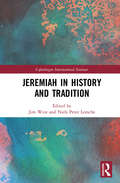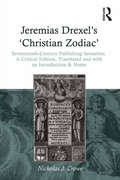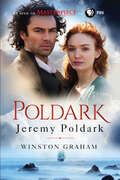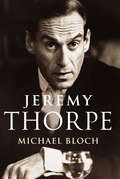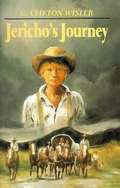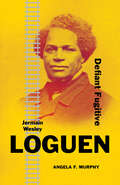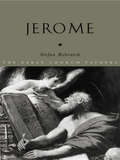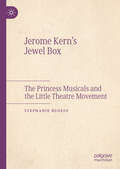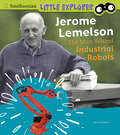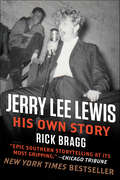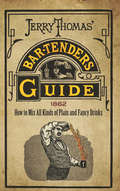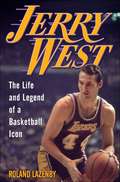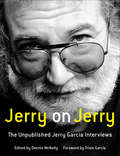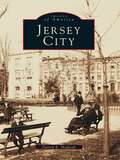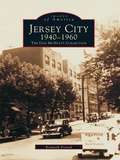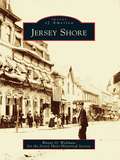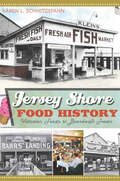- Table View
- List View
Jeremiah in History and Tradition (Copenhagen International Seminar)
by Jim West Niels Peter LemcheJeremiah in History and Tradition examines aspects of the Book of Jeremiah from a variety of perspectives including historical, textual, redaction, and feminist criticism, as well as the history of its reception. The book looks afresh at the Book of Jeremiah through the lens of intertextuality and reception history in the broadest sense, exploring Jeremiah in its historical context as well as the later history and interpretation of the text, and also reconsidering aspects of the Book of Jeremiah’s traditions. This volume features essays from a unique assembly of scholars, both seasoned and new. It is divided into two parts: "Jeremiah in History", which explores a variety of readings of Jeremiah from the point of view of classical historical criticism; and "Jeremiah in Tradition", which discusses the portraits and use of both the book and the figure of Jeremiah in extra-biblical traditions. Offering challenging new theories, Jeremiah in History and Tradition is invaluable to scholars and students in the field of Biblical Studies. It is a useful resource for anyone working on the interpretation of the biblical text and the readings of the text of Jeremiah throughout history.
Jeremiah, Lamentations (Reformation Commentary on Scripture Series #Ot Volume 11)
by J. Jeffery TylerThe prophetic ministry of Jeremiah, described in the Old Testament books of Jeremiah and Lamentations, took place during a time of chaos and tragedy for the people of Israel: the fall of Jerusalem, the destruction of the temple, and the exile to Babylon. Yet, in the midst of this loss and in hope of the restoration of God's people, Jeremiah is able to declare: "The steadfast love of the Lord never ceases; his mercies never come to an end; they are new every morning; great is your faithfulness" (Lam 3:22-23). Reflecting on these verses, Reformation commentators, who were themselves familiar with the turbulent realities of their own sixteenth century, heard not only hope for the renewal of Israel, but prophetic promise for the coming of the Messiah. Lutheran theologian and pastor Nikolaus Selnecker wrote, "Is not what Jeremiah says immeasurably beautiful, lovely, and consoling? You will think, what is my soul saying to me? That is a strong Amen, when the spirit of the heart knows and can say, 'God hears me, I know it. My heart tells me. I do not doubt God's grace. I am a child of God. He is my father and will help me.'" In this volume of the Reformation Commentary on Scripture, church historian J. Jeffery Tyler guides readers through a diversity of early modern commentary on the books of Jeremiah and Lamentations. Readers will hear from familiar voices and discover lesser-known figures from a variety of theological traditions, including Lutherans, Reformed, Radicals, Anglicans, and Roman Catholics. Drawing upon a variety of resources—including commentaries, sermons, treatises, and confessions—much of which appears here for the first time in English, this volume provides resources for contemporary preachers, enables scholars to better understand the depth and breadth of Reformation commentary, and seeks to help everyone remember that God's mercies never come to an end.
Jeremias Drexel's 'Christian Zodiac': Seventeenth-Century Publishing Sensation. A Critical Edition, Translated and with an Introduction & Notes
by Nicholas J. CroweFirst published in 1622, Jeremias Drexel's 'Zodiacus christianus' (or 'Christian Zodiac') was a remarkable work of religious iconography and spiritual self-help. Raised a Lutheran but converting to Catholicism in his youth, Drexel (1581-1638) was well placed to publish a book that appealed to Protestants as well as Catholics, his 'Zodiac' appearing in multiple reprints, re-editions and translations across Europe during his lifetime and posthumously across the rest of the seventeenth century in an astonishing arc of popularity. The orbit of his readers' catchment was geographically - and denominationally - wide to a conspicuous degree. Drexel was among the most-read authors of that century, a genuine luminary in the culture of the German Baroque, and arguably the most published writer of the period. Offering the first modern translation into English since the early seventeenth century, this critical edition re-acquaints Anglophone audiences with a sample of the spiritual and philosophical writings of a figure whose significant publication record made him a bestseller during his lifetime and for many decades afterwards. As well as addressing issues of spiritual iconography with relation to 'signs of predestination', the book also has much to say about authorship, publishing and the dissemination of ideas. Including a scholarly introduction, full footnotes and an up-to-date bibliography, this new edition does much to help reveal these themes within the complex interconnections between religion, mysticism, iconography and scholarship in early modern Europe.
Jeremy Poldark: A Novel of Cornwall, 1790-1791 (The Poldark Saga #3)
by Winston GrahamNOW A MASTERPIECE™ SERIES ON PBS®The gripping third book of historical fiction in the Poldark Saga following a family of revolutionary characters through romance, struggle, and the promise of new life.Revolutionary war veteran Ross Poldark faces the darkest hour of his life in this third novel of the Poldark Saga. Reeling from the tragic death of a loved one, Poldark vents his grief by urging impoverished locals to salvage the contents of a ship run aground in a storm—an act that demands death by hanging in the eyes of British law.Ross is brought to trial for his involvement, and despite their stormy marriage, Demelza tries to rally support for her husband, to save him and their family.But there are enemies in plenty who would be happy to see Ross convicted, not least of which is George Warleggan, the powerful banker whose personal rivalry with Ross grows ever more intense and threatens to completely destroy the Poldarks.And into this turbulent family saga, Jeremy Poldark, Ross and Demelza's first son, is born...The Poldark series is Winston Graham's masterwork, evoking the historical period and characters like only he can and creating an engrossing romance of rich and poor, loss and love, sure to engage fans of Downton Abbey and Outlander.
Jeremy Thorpe
by Michael Bloch'A revealing, insightful and gripping biography of one of the most extraordinary people ever to lead a British political party' ObserverThe story of Jeremy Thorpe's rapid rise and spectacular fall from grace is one of the most remarkable in British politics. When he became leader of the Liberal Party in 1967 at the age of just thirty-seven, he seemed destined for truly great things. But as his star steadily rose so his nemesis drew ever nearer: a time-bomb in the form of Norman Scott, a homosexual wastrel and sometime male model with whom Jeremy had formed an ill-advised relationship in the early 1960s. Scott's incessant boasts about their 'affair' became increasingly embarrassing, and eventually led to a bizarre murder plot to shut him up for good. Jeremy was acquitted of involvement but his career was in ruins.Michael Bloch's magisterial biography is not just a brilliant retelling of this amazing story; ten years in the making, it is also the definitive character study of one of the most fascinating figures in post-war British politics.
Jeremy Thorpe
by Michael Bloch'A revealing, insightful and gripping biography of one of the most extraordinary people ever to lead a British political party' ObserverThe story of Jeremy Thorpe's rapid rise and spectacular fall from grace is one of the most remarkable in British politics. When he became leader of the Liberal Party in 1967 at the age of just thirty-seven, he seemed destined for truly great things. But as his star steadily rose so his nemesis drew ever nearer: a time-bomb in the form of Norman Scott, a homosexual wastrel and sometime male model with whom Jeremy had formed an ill-advised relationship in the early 1960s. Scott's incessant boasts about their 'affair' became increasingly embarrassing, and eventually led to a bizarre murder plot to shut him up for good. Jeremy was acquitted of involvement but his career was in ruins.Michael Bloch's magisterial biography is not just a brilliant retelling of this amazing story; ten years in the making, it is also the definitive character study of one of the most fascinating figures in post-war British politics.
Jericho Mosaic: Sinai Tapestry, Jerusalem Poker, Nile Shadows, And Jericho Mosaic (The Jerusalem Quartet #4)
by Edward WhittemoreThe stunning conclusion to Edward Whittemore&’s Jerusalem Quartet: The remarkable story of an Israeli agent who infiltrates Syrian intelligence, keying victory in the Six Day WarYossi is an ideal agent for the Mossad—an Iraqi Jew, an idealist, and a charming loner, fluent in Arab dialects. Tajar, a brilliant agent, recruits and manages Yossi, code-named &“the Runner.&” Thus begins the longest-running and most successful operation in the history of Israeli intelligence. Yossi&’s cover is Halim, a Syrian businessman who has returned home from Buenos Aires and whose charm inspires high-level friendships. His reputation leads to an opportunity that he can&’t refuse: Tajar becomes a double agent infiltrating Syrian intelligence.Meanwhile, in the desert oasis of Jericho, Abu Musa, an Arab patriarch, and Moses the Ethiopian, meet each day over games of shesh-besh and glasses of Arak to ponder history and humanity. We learn about the friendship of Yossi&’s son, Assaf, an Israeli soldier badly wounded during the Six Day War, and Yousef, a young Arab teacher who, in support of the Palestinian cause, decides to live as an exile in the Judean wilderness.Jericho Mosaic is the final volume of the Jerusalem Quartet, which begins with Sinai Tapestry, Jerusalem Poker, and Nile Shadows. Steeped in the history and landscape of the Middle East, it is a story of idealism and dreams, hope and despair, and life&’s moments of breathtaking beauty.
Jericho's Journey
by G. Clifton WislerJericho Wetherby yearns for adventure, so he is thrilled when his father decides to move the family from Tennessee to Texas. In a lively first-person narrative, Jericho relates a string of colorful happenings on the westward trail. "A fast-paced, action-packed pioneer story". --Kirkus Reviews. Copyright © Libri GmbH. All rights reserved.
Jerk Husband: Volume 1 (Volume 1 #1)
by Mu ZiFive years ago, she married her husband. Four years ago, his husband went to the battlefield and became famous. It wasn't because he was an expert in martial arts, or that he used troops like a god. It was because he saved a person. She had followed her husband's instructions and had no intentions of stopping him from serving the country.
Jerk Husband: Volume 2 (Volume 2 #2)
by Mu ZiFive years ago, she married her husband. Four years ago, his husband went to the battlefield and became famous. It wasn't because he was an expert in martial arts, or that he used troops like a god. It was because he saved a person. She had followed her husband's instructions and had no intentions of stopping him from serving the country.
Jermain Wesley Loguen: Defiant Fugitive (Black Lives)
by Angela F MurphyA gripping biography of a man who escaped slavery to become an influential abolitionist, famously known as the &“King of the Underground Railroad&” Jermain Wesley Loguen (1813–1872) was a fugitive from slavery, an abolitionist, and a minister, teacher, and political activist. He worked alongside Harriet Tubman and Frederick Douglass, and his home in Syracuse, New York, was among the most publicized Underground Railroad stations in the northern states. Loguen&’s political commitments in the years before the Civil War were carried out at great personal risk, for he had liberated himself from slavery in Tennessee and was in constant danger of being captured and reenslaved under the Fugitive Slave Law. Defiantly, however, he refused to purchase his own freedom, an act that he believed would have legitimized the rights of slaveholders. In addition to aiding fellow fugitives from slavery, Loguen worked tirelessly to promote Black equality and uplift throughout upstate New York and Canada. After Emancipation, he extended his work to aid freedpeople in the South and to advocate for Black equality on a national scale. In this engaging study, Angela F. Murphy follows Loguen from his early years through his transformation into one of the brightest stars in the constellation of abolitionists and reformers in New York.
Jerome (The Early Church Fathers)
by Stefan RebenichAs a scholar, writer and ascetic, Jerome was a major intellectual force in the early Church and influenced the ideals of Christian chastity and poverty for many generations after his death. This book assembles a representative selection of his voluminous output. It will help readers to a balanced portrait of a complex and brilliant, but not always likeable man.
Jerome Kern’s Jewel Box: The Princess Musicals and the Little Theatre Movement
by Stephanie RuozzoJerome Kern’s Jewel Box shows how the integration of spoken and sung performances in Kern's early musicals reveals new connections between musical theater scores and “straight” (spoken) theater. Kern’s scores are foundational to the American musical, and subsequent dramatic music would be unrecognizable without Kern’s innovations. This book argues that Kern’s scores for a group of musicals staged at the Princess Theatre embody a musical corollary to the Realist drama of the Little Theatre Movement. The umbrella term “Princess musicals” includes the four musicals that Jerome Kern composed for New York City’s Princess Theatre: Nobody Home (1915), Very Good Eddie (also 1915), Oh, Boy! (1917), and Oh, Lady! Lady!! (1918), as well as Leave It to Jane (1917), a musical conceived for the Princess. Each separate Princess musical bears distinct hallmarks of Little Theatre sensibility, and that these hallmarks are overwhelmingly represented in the sung/musical portions of the drama. The book’s first chapter explores the influences of WWI and the Little Theatre Movement on the American stage (legitimate and musical). The subsequent chapters are studies of the five so-called “intimate musical comedies” that resulted from Kern’s engagement with these influences. The case studies all demonstrate how the shows’ scores advance the same artistic aims voiced by prominent members of the Little Theatre Movement. Ultimately, this project leads musical theater historians to reconsider the place of musicals in relation to the legitimate theatre and the historiography we construct around the “integrated” musical.
Jerome Lemelson: The Man Behind Industrial Robots (Little Inventor)
by Lucia RaatmaWhy is Jerome Lemelson important? His inventions helped create industrial robots, cassette players, and more! Readers follow his journey from struggling inventor to a multimillionaire with more than 600 patents. This story of determination is filled with engaging text and colorful images, all reviewed by Smithsonian experts.
Jerome of Stridon: His Life, Writings and Legacy
by Josef LösslThis book assembles eighteen studies by internationally renowned scholars that epitomize the latest and best advances in research on the greatest polymath in Latin Christian antiquity, Jerome of Stridon (c.346-420) traditionally known as "Saint Jerome." It is divided into three sections which explore topics such as the underlying motivations behind Jerome's work as a hagiographer, letter-writer, theological controversialist, translator and exegete of the Bible, his linguistic competence in Greek, Hebrew, and Syriac, his relations to contemporary Jews and Judaism as well as to the Greek and Latin patristic traditions, and his reception in both the East and West in late antiquity down through the Protestant Reformation. Familiar debates are re-opened, hitherto uncharted terrain is explored, and problems old and new are posed and solved with the use of innovative methodologies. This monumental volume is an indispensable resource not only for specialists on Jerome but also for students and scholars who cultivate interests broadly in the history, religion, society, and literature of the late antique Christian world.
Jerry Falwell and the Rise of the Religious Right: A Brief History With Documents
by Matthew Avery SuttonAs one of the most media-savvy ministers in U.S. history, Jerry Falwell figured prominently in the political mobilization of religious conservatives in the 1970s and early 1980s. Falwell’s life and work touched on almost all of the major issues of the time period: the cold war, changing gender roles, civil rights, the revitalization of American conservatism, and the Reagan revolution. <P><P> In his introductory essay, Matthew Avery Sutton traces Falwell’s politicization and rise to celebrity status, using Falwell as a lens through which to view the larger movement. More than two dozen primary documents focus on the Religious Right’s emergence in the 1970s as a powerful political force and present students with first-hand accounts of the era’s culture wars. <P><P>The thematically arranged documents – including sermons, letters, speeches, interviews, court documents, and children’s books – provide an up-close look at the motivations and aspirations of the Religious Right. Photographs, document headnotes, a chronology, questions for consideration, and a selected bibliography provide additional pedagogical support.
Jerry Herman: Poet of the Showtune
by Stephen CitronThis revealing and comprehensive book tells the full story of Jerry Herman's life and career, from his early work in cabaret to his recent compositions for stage, screen, and television. Stephen Citron draws on extensive open-ended interviews with Jerry Herman as well as with scores of his theatrical colleagues, collaborators, and close friends. The resulting book--which sheds new light on each of Herman's musicals and their scores--abounds in fascinating anecdotes and behind-the-scenes details about the world of musical theater. Readers will find a sharply drawn portrait of Herman's private life and his creative talents. Citron's insights into Herman's music and lyrics, including voluminous examples from each of his musicals, are as instructive as they are edifying and entertaining.
Jerry Lee Lewis: His Own Story
by Rick BraggThe greatest Southern storyteller of our time tracks down the greatest rock and roller of all time—and gets his own story, from the source, for the very first time.The New York Times BestsellerOne of Rolling Stone’s 10 Best Music Books of the YearA monumental figure on the American landscape, Jerry Lee Lewis spent his childhood raising hell in Ferriday, Louisiana, and Natchez, Mississippi; galvanized the world with hit records like “Whole Lotta Shakin’ Goin’ On” and “Great Balls of Fire,” that gave rock and roll its devil’s edge; caused riots and boycotts with his incendiary performances; nearly scuttled his career by marrying his thirteen-year-old second cousin—his third wife of seven; ran a decades-long marathon of drugs, drinking, and women; nearly met his maker, twice; suffered the deaths of two sons and two wives, and the indignity of an IRS raid that left him with nothing but the broken-down piano he started with; performed with everyone from Elvis Presley to Keith Richards to Bruce Springsteen to Kid Rock—and survived it all to be hailed as “one of the most creative and important figures in American popular culture and a paradigm of the Southern experience.”Jerry Lee Lewis: His Own Story is the Killer’s life as he lived it, and as he shared it over two years with our greatest bard of Southern life: Rick Bragg. Rich with Lewis’s own words, framed by Bragg’s richly atmospheric narrative, this is the last great untold rock-and-roll story, come to life on the page.“An enthralling look at the birth of rock & roll and the ensuing life of its arguably most colorful exponent.” —Entertainment Weekly
Jerry Thomas' Bartenders Guide: How To Mix All Kinds Of Plain And Fancy Drinks
by Jerry ThomasCare for a Morning Glory Cocktail, a Blue Blazer, or a Philadelphia Julep? Recipes for these and hundreds of other tasty libations appear in this landmark volume. Originally published in 1862, Jerry Thomas' Bartenders Guide is widely considered by drink historians as the first serious American book on cocktails and punches. "A new beverage is the pride of the bartender, and its appreciation and adoption his crowning glory," declared Jerry Thomas (1830–85), the most famous bartender of his era. Known as "the father of American mixology," Thomas developed the showy techniques practiced at his saloons throughout California and New York. From hot whiskey toddies to wedding punch to "temperance drinks," this extensive compilation of timeless recipes will delight modern-day mixologists and their guests. "There are so many bartending recipes in this book, it's doubtful you'll need any other guide." — The Paperback Stash.
Jerry West: The Life and Legend of a Basketball Icon
by Roland LazenbyWhen in 1969 the NBA sought an emblem for the league, one man was chosen above all as the icon of his sport: Jerry West. Silhouetted in white against a red-and-blue backdrop, West’s signature gait and left-handed dribble are still the NBA logo, seen on merchandise around the world. In this marvelous book—the first biography of the basketball legend—award-winning reporter and author Roland Lazenby traces Jerry West’s brilliant career from the coalfields near Cabin Creek, West Virginia, to the bare-knuckled pre-expansion era of the NBA, from the Lakers’ Riley-Magic-Kareem Showtime era to Jackson–Kobe–Shaq teams of the early twenty-first century, and beyond. But fame was not all glory. Called “Mr. Clutch,” West was an incomparable talent—flawless on defense, possessing unmatched court vision, and the perfect jumper, unstoppable when the game was on the line. Beloved and respected by fans and fellow players alike, West was the centerpiece of Lakers teams that starred such players as Elgin Baylor and Wilt Chamberlain, and he went on to nine NBA Finals. Yet in losing eight of those series, including six in a row to the detested Boston Celtics, West became as famous for his failures as for his triumphs. And that notoriety cast long shadows over West’s life on and off the court.
Jerry on Jerry: The Unpublished Jerry Garcia Interviews
by Dennis Mcnally Trixie GarciaListen in on hours of revelatory conversations with Jerry Garcia, one of the most beloved and missed figures in the world of music, with JERRY ON JERRY. More than twenty years after his death, at too young an age, Jerry remains a cultural icon whose influence and legacy endure. Now, these never-before-heard interviews reveal a candid and poignant side of Jerry, as he speaks openly on everything from religion and politics to his personal life and his creative process. Carefully selected by former Grateful Dead publicist and the band's authorized biographer, Dennis McNally, and curated with the cooperation of the Jerry Garcia Family, JERRY ON JERRY marks the first time these insightful and intimate archival recordings have ever been made available to the public.Here, Garcia talks about what it was like growing up in the San Francisco Bay Area, his obsession with his first guitar, and his first encounters with early R&B, which had a profound and lasting impact on his music. After discussing his brief, but eye-opening stint in the army, Jerry offers up stories of his time spent as a student of the Beats, and his personal and reverent memories of Neal Cassady. He ponders what he sees as the complicated nature of LSD and the oppressiveness of government. He goes on to remember in detail the early days of the Dead, from their first gigs as the Warlocks and their days at 710 Ashbury Street, to the Monterey Pop Festival in 1967 and performing on the road with Jefferson Airplane. Throughout he breaks to opine on movies (one of his favorite subjects), to open up about his songwriting process and his prolific collaboration with Robert Hunter, and his admiration for a broad range of musicians from the Rolling Stones and Bob Dylan to Scotty Stoneman and Bill Keith. Dozens of rare family photographs, and other art and ephemera, many of which have never been seen before, are included here in a PDF. With an introduction written and read by Dennis McNally, and a foreword written and read by Trixie Garcia, Jerry's daughter, this audiobook is the ultimate complement to any collection. JERRY ON JERRY is one of the most revealing and unguarded portraits of the adored front man of the Grateful Dead and a true, long-awaited gift to his fans.
Jersey City (Images of America)
by Patrick B. ShalhoubPatrick Shalhoub has brought together over two hundred fascinating photographs and prints of Jersey City which bring to life the people, places, and events which have created the city's vibrant and colorful history over the centuries. He takes us on a journey into the past. We see the farming communities which dominated the locality from the 1660s through the middle of the nineteenth century, when the area was part of the larger Bergen Township. We then experience the arrival of the immigrants, the advent of industrialization, and the rapid growth of Jersey City from a cluster of farmsteads and villages into the second largest city in New Jersey. Immigration has been the lifeblood of Jersey City's history, and through the images selected here we witness how Jersey City sprang to life with the influx of immigrants between 1830 and 1920-at first, Irish, German, and British, and, later, immigrants from southern and eastern Europe, including Italians, Poles, Russians, and Slovaks. African-Americans were present in Bergen Township from the early days of the city, but their numbers increased with the migration of laborers from the South in the first half of the twentieth century and their important contribution to the city continued. In recent decades, new communities have grown in Jersey City, including Latin American, Asian Indian, Egyptian, Filipino, and Haitian communities.
Jersey City 1940-1960: The Dan McNulty Collection
by Kenneth FrenchPhotographer Dan McNulty was a Jersey City resident who spent most of his time working in his family's funeral home. McNulty's photography was a mere sideline, but this fact did not affect the high artistic quality of the images of the city that he produced during the 1940s and '50s. During the two decades of McNulty's work, Jersey City experienced many changes. The powerful political machine of Mayor Frank Hague was brought down after thirty yearsin 1949 by the reform team of John V. Kenny, and this period also saw the end of the city's success in the railroad industry. In the 1950s, the first large housing projects were constructed in the city; other sweeping developments in this sphere would follow in the 1960s. McNulty documented these changes and others that resulted during this twenty year period through dramatic photographs of vacant railroad terminals, dynamic commercial and residential districts, successful factories and manufacturing plants, and significant WPA projects such as the Jersey City Medical Center and Roosevelt Stadium.
Jersey Shore
by Wayne O. Welshans Jersey Shore Historical SocietyJersey Shore, a small town with a seemingly misplaced name, was on the edge of the western frontier during Revolutionary War days, and those who settled in this area prior to 1784 found themselves outside the jurisdiction of both Great Britain and the commonwealth. Out of this was produced a Fair Play society, the Pine Creek Declaration of Independence, and something known as the Big Runaway. By 1800, a little village began to form along the banks of the west branch of the Susquehanna River. Over time, the West Branch Canal, lumbering, and a very large New York Central Railroad shop brought growth and prosperity to the area. Jersey Shore presents a visual story of the area through pictures taken by local photographers, including Joseph Mick, William H. Garman, and Jonathan Potter, dating from Civil War days to around 1930.
Jersey Shore Food History: Victorian Feasts to Boardwalk Treats (American Palate Ser.)
by Karen L Schnitzphan&“Chock full of photographs, the book dishes on food from the mid-1800s to the mid-1900s, all along the coast from Sandy Hook to Cape May.&” —RedBankGreen No trip to the Jersey Shore would be complete without indulging in the cuisine that helps make it famous. These foods we enjoy today are part of a long tradition beginning in the Victorian era, when big oceanfront hotels served elaborate meals. Diverse dishes and restaurants emerged during prohibition and the Great Depression, when fast food appeared and iconic boardwalk treats developed. Predating the farm to table movement, fancy and fast eateries have been supplied by local fishermen and farmers for decades. So whether you indulge in a tomato pie, pork roll or salt water taffy, take a mouthwatering historical tour and discover timeless treats from Sandy Hook to Cape May. &“Tells the story of the original farm and sea to table American destination. The book is filled with information about the way the NJ shore has eaten through history and the food establishments that have spanned generations, some still operating today.&” —NJ.com &“This book also gives us insights into the earliest days of Atlantic City&’s fine hotels. The Victorian era menus included in the volume are a treasure. I also loved her inclusion of such iconic former restaurants as Hackney&’s and Capt. Starn&’s and the still standing Knife and Fork Inn.&” —Atlantic City Central &“If you enjoy walking the Boardwalk for your pork roll and salt water taffy fix, or if you appreciate the history of the region&’s former great restaurants like Hackney&’s, Capt. Starn&’s and Zaberer&’s, this book will be an entertaining read.&” —Atlantic City Weekly
